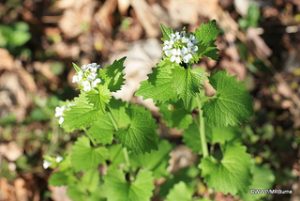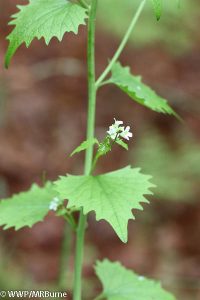Garlic Mustard
(Alliaria petiolata)
Family: Mustard Family (Brassicaceae)
Native Range: Europe

Overview: A cool season biennial herb, with leaves that smell like garlic when crushed. In the first year it grows as a rosette and in its second year it grows rapidly into a mature plants that flowers, produces seed and dies by late June.
Size: 2 to 3-½ feet in height
Leaves: Stalked, triangular to heart-shaped, coarsely toothed leaves that give off an odor of garlic when crushed. First-year plants appear as a rosette of green leaves close to the ground. Rosettes remain green through the winter and develop into mature flowering plants the following spring
Stem/Bark: Green
Flowers: Button-like clusters of small white flowers, each with four petals in the shape of a cross
Seed/Fruit: Seeds, which become shiny black when mature, are produced in May in erect, slender pods. A single plant can produce thousands of seeds
Roots: S-shaped taproot with fibrous roots
Reproduction: Only reproduces via seeds. Depending upon conditions, garlic mustard flowers either self-fertilize or are cross-pollinated by a variety of insects. Self-fertilized seed is genetically identical to the parent plant, enhancing its ability to colonize an area
Ecological Threat

- Outcompetes native plants, including toothworts which are the primary food source for the caterpillar stage of the West Virginia white butterfly (Pieris virginiensis)
- Allelopathic secretions prevent native plant growth. Toxic to the eggs of the WV white butterfly.
Distribution and Background
Garlic mustard was first recorded in the United States about 1868, from Long Island, New York and is now is widespread throughout North America. It was likely introduced by settlers for food or medicinal purposes. Humans and wildlife aid in the long-dispersal of the plant since seeds will attach to clothing, boots, car tires and animal hair.
Habitat Type
Frequently occurs in moist, shaded soil of river floodplains, forests, roadsides, edges of woods and trail edges and forest openings. Disturbed areas are most susceptible to rapid invasion and dominance. Though invasive under a wide range of light and soil conditions, garlic mustard is associated with calcareous soils and does not tolerate high acidity. Growing season inundation may limit invasion of garlic mustard to some extent.
Management Options
Management objectives are to prevent the spread of garlic mustard beyond its known boundaries, prevent seed production, and exhaust the seed bank. Seeds of garlic can remain viable in the soil for five years or more. Effective management requires a long term commitment and annual action (monitoring and/or active management).
Manual, mechanical and chemical control methods are effective in removing and killing garlic mustard. The method selected depends on the extent and type of infestation, the amount of native vegetation on the site, and the time, labor and available resources.
Biological
Several insects are being tested as a biological control, but none have been approved
Manual
- Hand pull the plant with its entire root system or new plants may sprout from root fragments.
- When hand-pulling is not practical, cut the flowering stems at ground level or within several inches of the ground to prevent seed production. If stems are cut too high, the plant may produce additional flowers at the leaf axils.
Mechanical
Fire has been used to control garlic mustard in some large natural settings but, because burning opens the understory, it can encourage germination of stored seeds and promote the growth of emerging garlic mustard seedlings. For this reason, burns must be conducted for three to five consecutive years. This method becomes less effective as first-year plants develop taproots.
Chemical
Application of a systemic herbicide to the foliage of garlic mustard is effective for heavy infestations where the risk to desirable plant species is minimal. First-year plants are most vulnerable, and second-year plants should be treated well before the seeds ripen. A 1-2% solution of a glyphosate herbicide such as Roundup Pro is most commonly used to control garlic mustard, although triclopyr herbicides such as Brush-B-Gone are also widely used.
Notice: Mention of Pesticide Products On This Web Site Does Not Constitute Endorsement Of Any Material. See Control and Disposal Methods for descriptions of application types and warnings.
Disposal
- Leave plant material on site to compost
- Bag materials in plastic and/or place material in direct sunlight to dry out faster
Look-alikes
Several white-flowered native plants occur in the same habitats as garlic mustard and may be mistaken for it.
- Cut-leaved toothwort (Cardamine concatenata) is smaller and has narrow, finger-like leaves
- Sweet cicely ( Osmorhiza claytonia and O. longistylis), which have fern-like leaves and five petals
- Early saxifrage (Saxifraga virginica), a small plant with clusters of 5-petalled white flowers
Alternative Plants (Alternative Native Species)
- White baneberry (Actaea pachypoda)
- Columbine (Aquilegia canadensis)
- Black cohosh (Cimicifuga racemosa)
More Information
For more information on invasive species in Massachusetts, refer to the Massachusetts Prohibited Plant List at https://www.mass.gov/massachusetts-prohibited-plant-list.